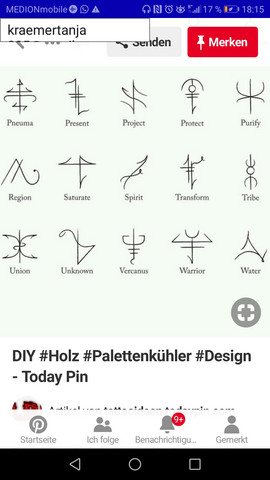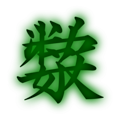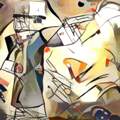Zeichen. Runen. Symbole Bedeutung?

Was sind das für Symbole und woher stammen sie?
6 Antworten

Ich bin bei meiner Google-Suche auf die Beschreibung ...
“Symbols derived from ancient Greek magickal kharakteres (characters). Examples of kharakteres may be found within the Greco-Egyptian magickal papyri, astrological symbolism, alchemical symbolism, and throughout the various grimoires. Each symbol embodies a specific conceptual building block pertinent to magickal use. These symbols encompass core concepts and actions used within the art of magick.”
... gestoßen.
Es handelt sich wohl um Symbole die auf antiken griechieschen magischen Zeichen basieren, welche wohl beispielsweise in den Papyri Graecae Magicae zu finden sind.

Runes are the letters in a set of related alphabets known as runic alphabets, which were used to write various Germanic languages before the adoption of the Latin alphabet and for specialised purposes thereafter. The Scandinavian variants are also known as futhark or fuþark (derived from their first six letters of the alphabet: F, U, Þ, A, R, and K); the Anglo-Saxon variant is futhorc or fuþorc (due to sound-changes undergone in Old English by the names of those six letters).
Runology is the study of the runic alphabets, runic inscriptions, runestones, and their history. Runology forms a specialised branch of Germanic linguistics.
The earliest runic inscriptions date from around 150 AD. The characters were generally replaced by the Latin alphabet as the cultures that had used runes underwent Christianisation, by approximately 700 AD in central Europe and 1100 AD in northern Europe. However, the use of runes persisted for specialized purposes in northern Europe. Until the early 20th century, runes were used in rural Sweden for decorative purposes in Dalarna and on Runic calendars.
The three best-known runic alphabets are the Elder Futhark (around 150–800 AD), the Anglo-Saxon Futhorc (400–1100 AD), and the Younger Futhark (800–1100 AD). The Younger Futhark is divided further into the long-branch runes (also called Danish, although they were also used in Norway, Sweden and Frisia); short-branch or Rök runes (also called Swedish-Norwegian, although they were also used in Denmark); and the stavlösa or Hälsinge runes (staveless runes). The Younger Futhark developed further into the Medieval runes (1100–1500 AD), and the Dalecarlian runes (c. 1500–1800 AD).
Historically, the runic alphabet is a derivation of the Old Italic scripts of antiquity, with the addition of some innovations. Which variant of the Old Italic family in particular gave rise to the runes is uncertain. Suggestions include Raetic, Venetic, Etruscan, or Old Latin as candidates. At the time, all of these scripts had the same angular letter shapes suited for epigraphy, which would become characteristic of the runes.
The process of transmission of the script is unknown. The oldest inscriptions are found in Denmark and northern Germany. A "West Germanic hypothesis" suggests transmission via Elbe Germanic groups, while a "Gothic hypothesis" presumes transmission via East Germanic expansion.

Sieht aus als wären die von Pinterest.

Google mal nach sigil. Es sieht für mich danach aus, aber ich kenne mich nicht genug aus, um es mit 100% Wahrscheinlichkeit sagen zu können.

Indianische Zeichen vielleicht???????